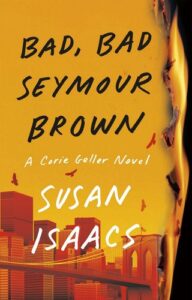Readers become writers the moment they glance away from the page, distracted by their own inner voice announcing, Hey, I can do that. In my case, it took a few nanoseconds more to sense that my first protagonist, would be, like me, a suburban Long Island mom. She’d have left behind a stimulating job (in my case, as a magazine editor and freelance political speechwriter) for the stay-at-home life. She’d be bright. Curious. Sardonic? Sure, why not? She adored her kids yet sometimes she yearned for discourse more elevated than pre-school repartee. Without a doubt, she was someone with whom I could identify.
The year was 1978 and Judith Singer became the protagonist of Compromising Positions. Even then I knew that anyone contemplating writing a mystery would be wise to make it Book 1 of a series. Unlike stand-alone crime fiction novels in which a single case is solved and the detective is no more, a well-written first mystery has an expectant fan base eager to snap up the next adventure. Readers plead to know And what happened after that? Lovers of clues and plot twists and intriguing characters don’t want to know from That’s all there is.
It was natural to wonder about creating another adventure for Judith and company, followed by yet another, after Compromising Positions’s surprise success. My publisher assured me that the gimlet-eyed, wise-cracking, less-than-happily-married sleuth would sparkle as a series protagonist. My vision was more sparkle, sparkle…tarnish. I imagined churning out increasingly implausible plots while Judith’s suburban town piled ever higher with bodies and the characters’ lovable quirks declined into tired schtick.
I knew that fate wasn’t inevitable. Some of the greatest mystery novelists did their best work in series: Ngaio Marsh, Georges Simenon, Sue Grafton, Michael Connelly. So of course some part of me always wanted to see what writing a series was all about.
But Compromising Positions was my first attempt at fiction. At that point, newly successful but uncertain about my future, I wasn’t sure I wanted to keep writing mysteries at all—and in the ensuing years, I often didn’t. I wrote many kinds of novels, including espionage, adventures, coming-of-age (and middle-age) tales, family sagas, and historical fiction. Often I found myself returning to mysteries, but they too were stand-alones.
After more than twenty years, I did decide to continue Judith’s story and wrote Long Time No See. I, too, wanted to know what had happened to her. How had she spent the last two decades? I also was in the mood to revisit our shared setting: suburban Long Island. However, Judith’s voice did not return to me immediately. As with any reunion with an old friend after so much time apart, there were moments where we clicked and moments where we didn’t quite get one another. But by the end of the first draft, she was back. Once again, she was so real to me I felt I was just her assistant, typing madly, trying to keep up with her dictation.
Still, after Long Time No See, I decided against any further Judith Singer sequels. I had described the totality of what happened to her in the intervening years, about her experience of growing older, about her now adult kids, her career, her love life. Her story felt final.
What I couldn’t quite let go of was Long Island. I live here, of course, but it has other attractions for a mystery writer. It’s diverse, with people of every race and ethnicity and in every economic bracket. Yet unlike cities, which display their grittiness on the surface, suburban grittiness is obscured by a patina of geniality. A murder turns the suburbs upside down.
So when I wrote It Takes One to Know One, I set it on Long Island. The protagonist Corie Geller is, as I once was, a recent transplant to Long Island from nearby Queens. Corie views her suburban setting skeptically, unlike her erudite, elegant, but less street-smart husband. She’s a former FBI agent, a linguistic maven who is fluent in Arabic, and a practitioner of martial arts. I wanted to make her background and training substantive enough so that she wasn’t Plucky Amateur Sleuth, but a shrewd investigator. I created Corie for the long haul. I wanted this to be the first book of my first series.
Continuing Corie’s story in Bad, Bad Seymour Brown felt like the natural next step: the second book. Corie’s voice remained not only loud and clear to me, but invigorating. She and I simply picked back up where we left off. Only a series could highlight Corie’s inner and outer selves and follow her evolution. She’s too gifted and maybe too flawed to have to cram all she is capable of and to a single book.
Corie Geller hangs with me now, my boon companion. She continues to surprise me with new aptitudes: her regard for Arab art and culture; her balance of Bureau-honed vigilance behind outer-borough affability, her grasp of family dynamics; her ability to hear the real message behind the most innocuous remark. She confides in me too, like about her longing for the man she knows she can never have. These days, as I work on my third Corie Geller book, I already have a glimmer of the fourth.
But the reason I am so glad — finally — to be writing a series? I’ve come to love Corie and there’s so much about her left to explore. There is no reason why we have to say goodbye.


















